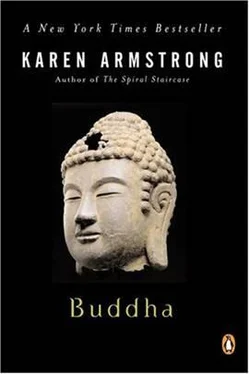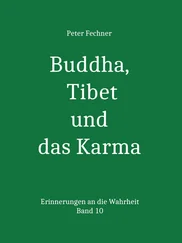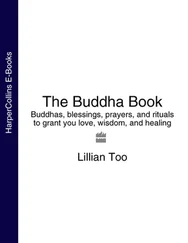Yet these were very elaborate arrangements for men who had embraced “homelessness.” Within a short space of time, the Buddha had acquired three large parks, at Rajagaha, Kapilavatthu and Savatthi, where the monks could live and meditate, surrounded by lotus pools, lush mango trees and shady cloisters of palms. Other donors quickly followed Anathapindika’s example. As soon as they heard that the Buddha was teaching in Savatthi, three bankers from Kosambi on the Jumna river came to hear him preach in Jeta’s Grove and promptly invited him to their own city. Each equipped a “pleasure-park” ( arama ) for the Sangha there. They not only raised buildings at their own expense, but, like the other donors, they maintained the arama, providing for its upkeep themselves. King Bimbisara employed so many servants for the Bamboo Grove that they filled an entire village. But the monks were not living in luxury. Though ample, the accommodation was simple and the huts sparsely furnished, as befitted followers of the Middle Way. Each bhikkhu had his own cell, but this was often just a partitioned-off area containing only a board to sleep on and a seat with jointed legs.
The bhikkhus did not live in these aramas year-round, but still spent most of their time on the road. At first, most even traveled during the monsoon, but found that this gave offense. Other sects, such as the Jains, refused to travel during the rains, because they would do too much damage to the wildlife, and this violated the principle of ahimsa. Why did these followers of Sakyamuni continue their journeys during the monsoon, people began to ask, “trampling down the new grass, distressing plants, and hurting many little creatures?” Even the vultures, they pointed out, stayed in the treetops during this season. Why did the Buddha’s monks alone feel obliged to trudge around the muddy paths and roads, taking no heed of anybody but themselves?
The Buddha was sensitive to this kind of criticism, and when he heard about these complaints, he made the monsoon retreat ( vassa ) obligatory for all Sangha members. But he went one step further than the other wanderers, and invented the monastic communal life. Monks in the other sects either lived alone during the vassa, or they put up wherever they happened to be, sharing a forest clearing with ascetics who followed quite different dhammas. The Buddha ordered his bhikkhus to live together during the vassa, not with members of other sects; they could choose one of the aramas or a country settlement ( avasa ), which the monks built each year from scratch. Each arama and avasa had fixed boundaries; no monk was allowed to leave the retreat for more than a week during the three months of the monsoon, except for a very good reason. Gradually, the monks began to evolve a community life. They devised simple ceremonies, which took place in the assembly hall of their settlement. In the morning, they would meditate and listen to the instructions given by the Buddha or one of the senior monks. Then they set off with their bowls to the town to seek the day’s provisions, and ate their main meal. In the afternoon there would be a siesta, followed by more meditation in the evening.
But above all, the bhikkhus had to learn to live together amicably. The inevitable difficulties of living with people whom they might not find personally congenial would put the equanimity they were supposed to have acquired in meditation to the test. It was no good radiating compassion to the four quarters of the earth if bhikkhus could not be kind to one another. There were times when the Buddha had to take his monks to task. Once he rebuked them for failing to take care of a bhikkhu who had dysentery. On another occasion, when the Buddha and his entourage were traveling to Savatthi, a clique of monks went ahead to one of their local settlements and secured all the beds. Poor Sariputta, who seems to have had a bad cough, had to spend the night outside under a tree. Such rudeness, the Buddha told the guilty monks, undermined the whole mission of the Sangha, since it would put people off the Dhamma. But gradually, the best of the bhikkhus learned to set aside their own selfish inclinations and consider their fellows. The person who returned first from town with the alms-food made the hut ready for the others, setting out the seats and preparing the water for cooking. The one who arrived home last ate the leftovers and put everything away. “We are very different in body, Lord,” one of the monks told the Buddha about his community, “but we have, I think, only one mind.” Why should he not ignore his own likes and dislikes, and do only what the others wished? This bhikkhu felt lucky to be living the holy life with such companions. In the communal life of the vassa, the Buddha had found another way to teach his monks to live for others.
King Pasenedi of Kosala was very impressed by the friendliness and cheerfulness of life in the Buddhist aramas. It was in marked contrast to that of the court, he told the Buddha, where selfishness, greed and aggression were the order of the day. Kings quarreled with other kings, brahmins with other brahmins; families and friends were constantly at loggerheads. But in the arama, he saw bhikkhus “living together as uncontentiously as milk with water and looking at one another with kind eyes.” In other sects, he noticed that the ascetics looked so skinny and miserable that he could only conclude that their lifestyle did not agree with them. “But here I see bhikkhus smiling and courteous, sincerely happy… alert, calm and unflustered, living on alms, their minds remaining as gentle as wild deer.” When he sat in council, the king remarked wryly, he was constantly interrupted and even heckled. But when the Buddha addressed a huge crowd of monks, none of them even coughed or cleared his throat. The Buddha was creating an alternative way of life that brought the shortcomings of the new towns and states into sharp focus.
Some scholars believe that the Buddha saw such rulers as Pasenedi and Bimbisara as partners in a program of political and social reform. They suggest that the Sangha was designed to counter the rampant individualism that was inevitable as society progressed from a tribal, communal ethos to a competitive, cutthroat market economy. The Sangha would be a blueprint for a different type of social organization, and its ideas would gradually filter down to the people. They point to the frequent juxtaposition of the Buddha and the cakkavatti in the texts: the Buddha was to reform human consciousness, they suggest, while the kings introduced social reforms. More recently, however, other scholars have argued that far from endorsing monarchy and working with it in this way, the Buddha seemed highly critical of kingship and preferred the republican style of government that still prevailed in his native Sakka.
It seems unlikely that the Buddha had such political ambitions; he would surely have regarded any involvement with a social program as an unhelpful “clinging” to the profane world. But the Buddha was certainly trying to forge a new way of being human. The evident contentment of his bhikkhus showed that the experiment was working. The monks had not been infused by supernatural grace or reformed at the behest of a god. The method devised by the Buddha was a purely human initiative. His monks were learning to work on their natural powers as skillfully as a goldsmith might fashion a piece of dull metal and make it shining and beautiful, helping it to become more fully itself and achieve its potential. It seemed that it was possible to train people to live without selfishness and to be happy. If the bhikkhus had been gloomy or frustrated, this would probably show that their lifestyle was doing violence to their humanity. “Unskillful” states, such as anger, guilt, unkindness, envy and greed, were avoided not because they had been forbidden by a god or were “sinful” but because the indulgence of such emotions was found to be damaging to human nature. The compassion, courtesy, consideration, friendliness and kindness required by the monastic life constituted the new asceticism. But unlike the old, extreme tapas, it created harmony and balance. If cultivated assiduously, it could evoke the ceto-vimutti of Nibbana, another eminently natural psychological state.
Читать дальше












